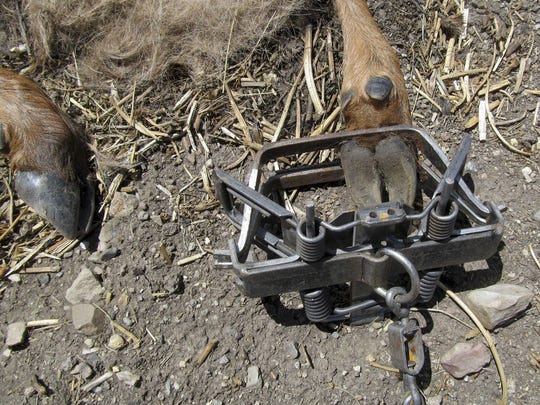It may still come as a surprise that today, in 2019, it is still legal in New Mexico to set a steel-jawed leg-hold trap or strangling wire snare in order to catch any one of 16 kinds of native wild animal that includes bobcats, foxes and badgers, for fun and profit.
Trapping is legal nearly statewide with the approval of the State Game Commission by purchasing a $20 license. In recent years, dozens of hikers’ dogs have been caught in traps hidden on land open to the public, including my own. The number of reported incidents is most certainly just the tip of the iceberg. The only incidents the public knows about have been reported to TrapFreeNM.org, a coalition of conservation and animal protection groups.

The hooves of an elk calf can be seen caught in a steel trap. (Photo: Photo by NDOW)
It is legal to hide a trap a mere 25 yards from a road or designated trail. Traps can also be placed right in the middle of a non-designated game trail, as I found out 18 months ago when one of my dogs stepped in one.
I was looking at birds in the wide canyon bottom. My camera was out and my two dogs were both leashed beside me. A road runs up one side of this canyon but I don’t like to walk on it — I don’t want to be where traffic might be. And interesting wildlife I like to view doesn’t confine itself just to roads. Hikers, birdwatchers and hunters are not required to stay only on roads or agency trails.
I will never forget my dog’s screams. I have made a point to learn how to open a trap and thankfully, this one was a kind that I physically could open. I had her out within a minute. Still her foot and my hand were both injured in the frantic rescue. It felt like someone had committed an assault on me. It felt like violent crime.
The Game Commission is now considering the closure of some limited areas to trapping, specifically the national forest portion of the Sandia Mountains, the Organ Mountains east of Las Cruces, a half-mile on either side of the road from Santa Fe to the ski basin and from Taos to the ski valley and half-mile from any official trailhead. These areas are all near populated places and presumably get high use. That any areas have been proposed for closure is a nod that traps and public use are not compatible. If approved, it is wonderful that hikers and wildlife in these places won’t be at risk. But why should this not be true everywhere? Do animals in the Sacramento Mountains suffer any less? Are critically endangered Mexican wolves harmed or maimed by traps in the Gila not worthy of protection from trap injury? Are hikers like me in Socorro county, or near Chama, or in the Jemez away from population centers of no consequence?
We don’t accept that a little bit of thievery is OK as long as it happens to only a few people. A little bit of vandalism is still wrong and considered a crime now matter how much property is defiled. Fraud is not OK even if only a few are conned. These things are illegal because they are wrong. Trapping anywhere that others can be harmed is wrong too.
At the August Game Commission meeting one of Gov. Michelle Lujan Grisham’s newly appointed commissioners told of having met with trappers and opined that they were really nice guys. Well, I’m a nice person and my dogs are nice as well. This isn’t a personality contest. It is about justice, fairness, ethics and morality. It is about what is right. Hiding traps on our public lands isn’t. If you agree, you may visit http://www.wildlife.state.nm.us/commission/proposals-under-consideration/ to read about the inadequate changes to the trapping rules and for the link where you can submit your own written comments.
